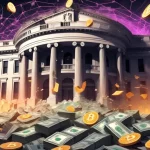U.S. Treasury Embraces Crypto, Aims for Global Leadership with Stablecoins

America Goes Big on Crypto: From Industry Starvation to Global Leadership
The U.S. government is shifting gears, moving from neglect to a supportive stance on digital assets. Treasury Secretary Scott Bessent aims to make the U.S. a global leader in cryptocurrency through regulatory clarity and a focus on stablecoins.
- U.S. Treasury shifts to crypto support
- Stablecoins to drive $2T Treasury demand
- Bipartisan Senate bill moves forward
- Trump hosts TRUMP meme coin dinner
Under Bessent’s leadership, the U.S. Treasury is breaking away from the restrictive policies of the past. He emphasized,
“The government is ‘going big’ on crypto, a striking contrast with the previous administration, which took a restrictive approach that left many companies struggling to survive.”
The new approach seeks to provide digital asset companies with the regulatory clarity they need to thrive, as Bessent added,
“Digital asset companies deserve regulatory clarity, and that’s exactly what we are working toward.”
Stablecoins, cryptocurrencies designed to minimize price volatility by pegging their value to stable assets like the U.S. dollar, are at the heart of this shift. Bessent projected that they could increase the demand for U.S. Treasuries by up to $2 trillion, highlighting significant liquidity benefits. This move aligns with the views of Tether CEO Paolo Ardoino, who has argued that stablecoins like USDT bolster the hegemony of the U.S. dollar.
Legislative momentum is building in the Senate, where a bipartisan stablecoin bill recently cleared a procedural hurdle, advancing with a 66–32 vote to end a filibuster. Crypto-supporting Democrats, including Senators Kirsten Gillibrand and Angela Alsobrooks, brokered key changes to the bill, dropping demands for a ban on former President Trump profiting from his family’s crypto investments. While the bill’s final vote may not occur until after the Memorial Day recess, its progress signals a growing acceptance of digital assets in the legislative arena.
Meanwhile, the Treasury is also considering the removal of the supplementary leverage ratio (SLR), a post-2008 crisis safeguard requiring banks to hold more capital against trading Treasuries. This move could enhance liquidity in the $29 trillion market and potentially lower Treasury yields, further intertwining traditional finance with the crypto world.
In a surprising turn, former President Donald Trump is diving headfirst into the crypto community. He recently hosted a dinner for the top 220 holders of his TRUMP meme coin at his private golf club, raising $148 million (though some sources claim a higher total of $394 million spent by investors). This move has sparked debates about political influence and ethics in the crypto space, with Trump declaring,
“The U.S. is ‘dominating in crypto, bitcoin, etc.,’ vowing to ‘keep it that way.'”
Legal experts like Tracey Beryl Gallagher have raised concerns, suggesting that Trump’s use of the Presidential Seal at the event might violate federal law. Ethical concerns are also mounting, with experts like Daniel Weiner and Donald Sherman pointing out the unprecedented nature of a president attending a dinner for investors in a business he owns.
Trump’s dinner with meme coin holders? That’s one way to make a meal out of crypto. But while it’s all fun and games at the dinner table, the broader implications of such political involvement in crypto can’t be ignored. Meme coins, often lacking intrinsic value and driven by hype, are prime targets for scams like “pump and dump” schemes. The concentration of influence among Trump-linked entities and the risk of foreign influence raise red flags. And let’s not forget the transparency issue—no official guest list was released.
This blend of regulatory support and high-profile political involvement underscores the U.S.’s ambition to lead the global crypto revolution. However, it also raises questions about the potential for conflicts of interest and the need for robust regulations to prevent market manipulation and ensure transparency.
Key Takeaways and Questions
- What is the U.S. government’s new approach to digital assets?
The U.S. government, under Treasury Secretary Scott Bessent, is adopting a supportive stance towards digital assets, focusing on regulatory clarity and enhanced AML standards, particularly for stablecoins, to position the country as a global leader in the sector.
- How does the administration plan to regulate stablecoins?
The administration aims to tighten anti-money laundering standards for stablecoins while providing regulatory clarity to encourage innovation and institutional participation.
- What impact do stablecoins have on U.S. Treasuries?
Stablecoins are projected to generate a $2 trillion demand for U.S. Treasuries, significantly increasing liquidity in traditional markets without weakening oversight.
- What is the current status of the bipartisan stablecoin bill in the U.S. Senate?
The bill has cleared a procedural roadblock, allowing debate on the floor after a 66–32 vote to end a filibuster, though a final vote may not occur until after the Memorial Day recess.
- What changes were made to the stablecoin bill to facilitate its progress?
Key changes brokered by crypto-supporting Democrats, including dropping demands for a ban on Donald Trump profiting from his family’s crypto investments.
- What is the supplementary leverage ratio (SLR) and how might its removal affect the Treasury market?
The SLR is a post-2008 crisis safeguard requiring banks to hold more capital against trading Treasuries. Its removal could increase liquidity in the $29 trillion market and lower Treasury yields.
- What is the significance of Donald Trump’s involvement with the TRUMP meme coin?
Trump’s hosting of a dinner for top holders of the TRUMP meme coin highlights the political relevance of crypto and raises ethical concerns about influence and transparency.
- What are the potential ethical concerns surrounding Trump’s crypto dinner?
Concerns include the concentration of influence among Trump-linked entities, the risk of foreign influence, and the transparency of the event, given that no official guest list was released.



